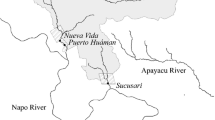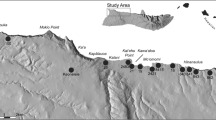Abstract
Native peoples have often been portrayed as natural conservationists, living in “harmony” with their environment. It is argued that this perspective is a result of an imprecise definition of conservation that emphasizes effects rather than actual behavior. Using foraging theory as a contrast, an operational definition of conservation is offered. Foraging theory assumes that foragers will behave to maximize their short-term harvesting rate. Hunting decisions that are costly in terms of short-term harvest rate maximization, yet increase the sustainability of the harvest are deemed conservation. Using this definition, alternative hypotheses are tested using data on the inter-specific prey choice decisions of a group of subsistence hunters, the Piro of Amazonian Peru. Results indicate that hunters do not show any restraint from harvesting species identified as vulnerable to over-hunting and local extinction. Decisions are made that are consistent with predictions of foraging theory.
Similar content being viewed by others
References
Altmann, J. (1974). Observational study of behavior: sampling methods.Behavior 49: 227–267.
Alvard, M. (1993). Testing the Ecologically Noble Savage Hypothesis: Conservation and Subsistence Hunting by the Piro of Amazonian Peru. Ph.D. Dissertation, University of New Mexico, Albuquerque.
Alvard, M. (in press). Conservation by native peoples? Prey choice in a depleted area.Human Nature.
Alvard, M., and Kaplan, H. (1991). Procurement technology and prey mortality among indigenous neotropical hunters. In Stiner, M. (ed.),Human Predators and Prey Mortality. Westview Press, Boulder, pp. 79–104.
Berlin, O., and Berlin, E. (1977).Etnobiología, Subsistencia y Nutritión en una Sociedad de la Selva Tropical: Los Aguaruna. University of California Press, Berkeley.
Bodley, J. (1976).Anthropology and Contemporary Human Problems. Benjamin Cummings Publishing, Menlo Park, California.
Bodley, J. (1990).Victims of Progress (3rd Ed.). Mayfield Publishing, Moutainview, CA.
Borgerhoff-Mulder, M., and Caro, T. (1985). The use of quantitative observational techniques in anthropology.Current Anthropology 26: 323–335.
Bunyard, P. (1989). Guardians of the Amazon.New Scientist 35: 38–41.
Camino, A. (1977). Trueque, correrías e intercambios entre los Quechuas Andinos y los Piro y Machiguenga de la montaña Peruana.Amazonía Peruana 1: 1–27.
Caughley, G. (1977).Analysis of Vertebrate Populations. John Wiley & Sons, London.
Clark, C. (1990).Mathematical Bioeconomics: The Optimal Management of Renewable Resources. John-Wiley & Sons, New York.
Clay, J. (1988).Indigenous Peoples and Tropical Forests: Models of Land Use and Management from Latin America. Cultural Survival, Cambridge.
Cole, L. (1954). The population consequences of life history phenomena.Quarterly Review of Biology 29: 103–137.
Diamond, J. (1986). The golden age that never was.Discover 9: 70–79.
Fragoso, J. (1991). The effect of hunting on tapirs in Belize. InNeotropical Wildlife Use and Conservation. Robinson, J., and Redford, K. (eds.), Chicago University, Chicago, pp. 154–162.
Gentry. A. (1990).Four Neotropical Forests. Yale University Press, New Haven.
Gross, D. (1975). Protein capture and cultural development in the Amazon.American Anthropologist 77: 526–549.
Hames, R. (1979). A comparison of the efficiencies of the shotgun and the bow in neotropical forest hunting.Human Ecology 7: 219–252.
Hames, R. (1987). Game conservation or efficient hunting? In McCay, B., and Acheson, J. (eds.),The Question of the Commons. University of Arizona Press, Tucson, pp. 97–102.
Hames, P. (1991). Wildlife Conservation in tribal societies. In Oldfield, M., and Alconn, J. (eds.),Biodiversity; Culture, Conservation and Ecodevelopment. Westview Press, Boulder, CO, pp. 172–199.
Hames, R., and Vickers, W. (1982). Optimal diet breadth theory as a model to explain variability in Amazonian hunting.American Ethnologist 9: 357–378.
Hardin, G. (1968). The tragedy of the commons.Science 162: 1243–1248.
Harris, M. (1977).Cannibals and Kings. Random House, New York.
Hayne, D., and Gwynn, J. (1977). Percentage does in total kill as a harvest strategy.Proceedings of the Joint Northwest-Southwest Deer Study Group Meeting, pp. 117–127.
Keinen, J., and Low, B. (1992). Human Behavioral Ecology and environmental conservation.Environmental Conservation 19: 105–116.
Hennemann, W. (1983). Relationship among body mass, metabolic rate and the intrinsic rate of natural increase in mammals.Oecologia 56: 104–108.
Hill, K., and Hawkes, K. (1983). Neotropical Hunting among the Ache of Eastern Paraguay. In Hames, R., and Vickers, W. (eds.),Adaptive Responses of Native Amazonians. Academic Press, New York, pp. 139–188.
Hill, K., Kaplan, H., Hawkes, K., and Hurtado, A. (1987). Foraging decisions among Ache hunter-gatherers. New data and implications for optimal foraging models.Ethnology and Sociobiology 8: 1–36.
Holdrige, L. (1967).Life Zone Ecology. Tropical Science Center, San José, Costa Rica.
Hughes, J. (1983).American Indian Ecology. Texas Western Press, El Paso.
Hunn, E. (1982). Mobility as a factor limiting resource use in the Columbia Plateau of North America. In Williams, N., and Hunn, E. (eds.),Resource Managers: North American and Australian Hunter-Gatherers. Westview Press, Boulder, pp. 17–43.
Kaplan, H., and Hill, K. (1992). The evolutionary ecology of food acquisition. In Smith, E., and Winterhalder, B. (eds.),Evolutionary Ecology and Human behavior. New York, Aldine de Gruyter, pp. 167–202.
Kay, J. (1990).Yellowstone's Northern Elk Herd: A Critical Evaluation of the “Natural Regulation” Paradigm. Ph.D. dissertation, Utah State University, Logan.
Krebs, J., and McCleery, R. (1984). Optimization in behavioral ecology. In Krebs, J., and Davies, N. (eds.),Behavioral Ecology: An Evolutionary Approach. Sinauer Associates, pp. 91–121.
Kuchikura, Y. (1988). Efficiency and focus of blowgun hunting among Semaq Beri hunter-gatherers of peninsular Malaysia.Human Ecology 16: 271–305.
Lewontin, R. (1970). The units of selection.Annual Review of Ecology and Systematics 1: 1–18.
MacArthur, R. (1960). On the relation between reproductive value and optimal predation.Proceedings of the National Academy of Science 46: 143–145.
McCay, B., and Acheson, J. (eds.) (1987).The Question of the Commons. University of Arizona Press, Tucson.
McCullogh, D. (1984). Lessons from the George Reserve, Michigan. In Halls, L. (eds.),White Tailed Deer: Ecology and Management. Stackpole Books, Harrisburg, PA, pp. 211–242.
McDonald, D. (1977). Food taboos: A primitive environmental protection agency:Anthropos 72: 734–748.
McNamara, J., and Houston, A. (1987). Partial preferences and foraging.Animal Behavior 35: 1084–1099.
Meggers, B. (1971).Amazonia: Man and Culture in a Counterfeit Paradise. Aldine-Atherton, Chicago.
Mittermeier, R., and Cheney, D. (1987). Conservation of primates and their habitats. In Smuts, B., Cheney, D., Seyfarth, R., Wrangham, R., and Struhsakar, T. (eds.),Primate Societies. Chicago University Press, Chicago, pp. 477–490.
Nietschmann, B. (1978). Comments on Ross.Current Anthropology 19: 24–25.
Posey, D. (1982). Indigenous ecological knowledge and development of the Amazon. In Moran, E. (ed.),The Dilemma of Amazonian Development University of Colorado, Boulder, pp. 225–257.
Posey, D. (1985). Native and indigenous guidelines fore new Amazonian development strategies: Understanding biodiversity through ethnocology. In Hemming, J. (ed.),Change in the Amazon. Manchester University Press, Manchester, pp. 156–181.
Pyke, G., Pulliam, H., and Charnov, E. (1977). Optimal foraging: A selective review of theory and tests.Quarterly Review of Biology 52: 137–154.
Redford, K. (1991). The ecologically noble savage.Orion 9: 24–29.
Ricker, W. (1954). Stock and recruitment.Journal of the Fish Research Board of Canada 11: 559–623.
Robinson, J., and Redford, K. (1986). Intrinsic rate of natural increase in Neotropical forest mammals: Relationship to phylogeny and diet.Oecologia 68: 516–520.
Robinson, J., and Ramirez, J. (1982). Conservation biology of neotropical primates.Special Publication of the Pymatuning Laboratory of Ecology 6: 329–344.
Robinson, J., and Redford, K. (1991). Sustainable harvest of neotropical wildlife. In Robinson, J., and Redford, K. (eds.),Neotropical Wildlife Use and Conservation. Edited by University of Chicago, Chicago, pp. 415–429.
Rogers, A. (1991). Conserving resources for children.Human Nature 2: 73–82.
Ross, E. (1978). Food taboos, diet, and hunting strategy: The adaptation to animals in Amazon cultural ecology.Current Anthropology 19: 1–36.
Savidge, I., and Ziesenis, J. (1980). Sustained yield management. In Schmnitz, S. (ed.),Wildlife Management Techniques Manual. The Wildlife Society, Washington, D.C., pp. 405–410.
Silva, J., and Strahl, S. (1991). Human impact on populations of chachalacas, guans, and currassows (Galliformes: Cracidae) in Venezuela. In Robinson, J., and Redford, K. (eds.),Neotropical Wildlife Use and Conservation. Chicago University Press, Chicago, pp. 37–52.
Simms, S. (1992). Wilderness as human landscape. In Zeveloff, S., Vause, L., and McVaugh, W. (eds.),Wilderness Tapestry: An Eclectic Approach to Preservation. University of Nevada Press, Reno, Nevanda, pp. 183–201.
Smith, E. (1983). Anthropological applications of optimal foraging theory: A critical theory.Current Anthropology 24: 625–651.
Smith, E. (1991).Inujjuamiut Foraging Strategies: Evolutionary Ecology of an Arctic Hunting Economy. Aldine, New York.
Smith, E. (1992). Human behavioral ecology.Evolutionary Anthropology 1: 20–25.
Speck, F. (1939). Aboriginal conservators.Bird Lore 40: 258–261.
Stephens, D., and Krebs, J. (1986).Foraging Theory. Princeton University Press, Princeton.
Terborgh, J. (1983).Five New World Primates. Princeton University Press, Princeton.
Terborgh, J., Fitzpatrick, J., and Emmons, L. (1984). An annotated list of the birds and mammals of Cocha Cashu Biological Station.Fieldiana 21: 1–29.
Western, D. (1983). Production, reproduction and size in mammals.Oecologia 59: 269–271.
Williams, G. (1966).Adaptation and Natural Selection. Princeton University Press, Princeton.
Wynne-Edwards, V. (1962).Animal Dispersion in Relation to Social Behavior. Hafner, New York.
Yost, J., and Kelly, P. (1983). Shotguns, blowguns, and spears: The analysis of technological efficiency. In Hames, R., and Vickers, W. (eds.),Adaptive Responses of Native Amazonians. Academic Press, New York, pp. 189–224.
Author information
Authors and Affiliations
Additional information
The phrase “ecologically noble savage” was coined by Kent Redford (1991) in a thought provoking article of the same name.
Rights and permissions
About this article
Cite this article
Alvard, M.S. Testing the “ecologically noble savage” hypothesis: Interspecific prey choice by Piro hunters of Amazonian Peru. Hum Ecol 21, 355–387 (1993). https://doi.org/10.1007/BF00891140
Issue Date:
DOI: https://doi.org/10.1007/BF00891140




